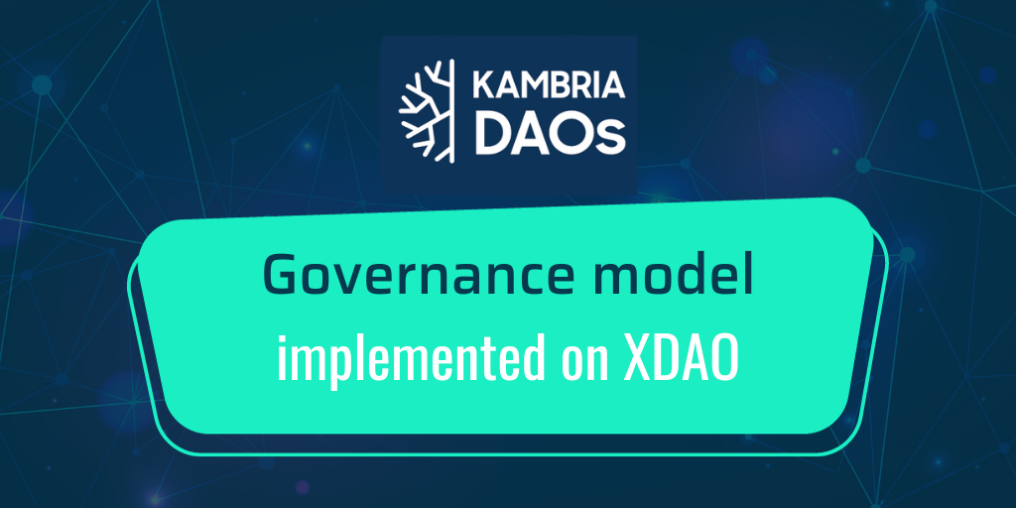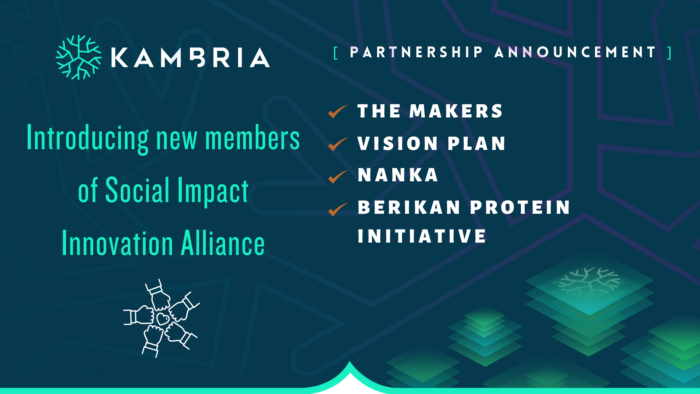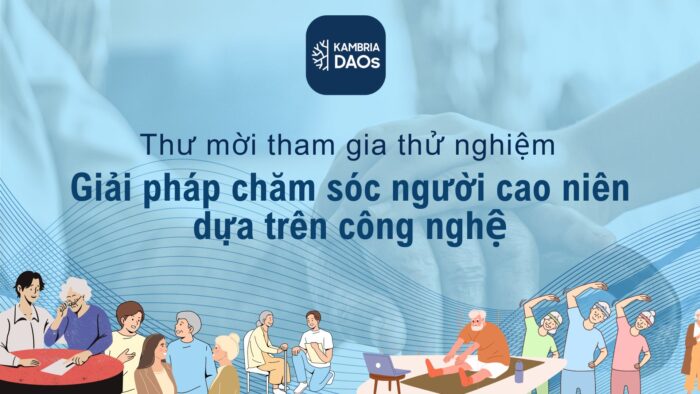KAMBRIA - This article introduces Kambria DAOs governance model and how we implement it on XDAO, regarding GT - LP tokens, Development work management, Commercialization and Revenue sharing management of the DAOs. (Last updated: Sep 17, 2023)

Introduction
Dear Kambrians,
In a previous article, we introduced an overview of the Kambria DAO model as a way for the community to co-own a technology.
| Co-owning technology via Kambria DAOs A DAO (Decentralized Autonomous Organization) is a community using blockchain to facilitate decentralized autonomy. The control is spread out among all community members who use governance tokens to vote on DAO’s rules or changes, voting power is equivalent to the number of tokens they possess. By this, we can empower the community with trust, transparency, and automation, and enable open-source solutions to be commercialized by their community. Each Kambria DAO is started by a Dev Team submitting their proposal with a solution of technology they can develop and open for the community to co-own. The community collectively buys into the solution by participating in the DAO. Then Dev Team starts to develop the solution and the development progress will be managed monthly. The DAO as owners of the solution will decide and contribute to the commercialization of the solution, as well as get paid for their contribution. Please check this page for a more detailed model and FAQs of Kambria DAOs. |
This time, let’s look further at how to implement that model, using XDAO as a platform for DAO creation and management.
LP (Liquidity Provider) token
Understanding XDAO’s LP token
LP token is an ERC20 standard token representing a financial interest in the organization.
LP tokens are used to track individual contributions to the DAO treasury, as LP tokens held correspond proportionally to the share of liquidity in the DAO treasury.
By purchasing DAO LP tokens, you have a proportional part of the whole DAO assets:
DAO AUM / Circulating Supply of LP Tokens = Value of 1 LP Token
You can purchase DAO LP tokens via private offers or public offers. A private offer gives an opportunity to buy only a certain number of LP tokens to a certain user. The public offer allows an unlimited number of users to buy an unlimited number of tokens.
In case you want to withdraw your fund, you can burn your LP tokens and get all DAO assets proportional to the share. As a result of the burning, the shares in the DAO will be redistributed among the rest of the participants, and the one who burned his/her share will receive all selected tokens.
Kambria DAO’s fundraising approach with LP token
1. Variable supply would be more suitable for Kambria DAOs in the early phase, to allow possible changes and improvements until we reach the optimized model.
2. We will run a round of Private offers for big investors and then create a Public offer for the community to participate.
3. The typical fund goal for each DAO is $3M for multiple product cycles. and the number of DAO LP tokens to be issued is 10M. So LP token price is 0.3$.
- We can start the Development phase upon completing the fund goal of that product cycle.
4. The currencies to buy LP tokens are KAT or USDT. The rate 1 LP = XX KAT would be determined by KAT price on CMC at the time of purchase. For example, if KAT price is 0.03 then 1 LP = 10 KAT.
5. As per common practices, withdrawals will be limited in the first year to reduce risks in the early stage.
There are 2 mechanisms to do this:
- Disable LP burning: available option currently supported by XDAO.
- Vesting: in the XDAO development plan, or could be developed by the Kambria team as a module integration to the XDAO platform. Vesting timely in 1 year would be a standard process.
After further exploration, developing smart contracts to integrate to XDAO is our chosen approach to ensure the implementation aligns with our design.
6. The DAO LP tokens will be listed in the 2nd year.
7. Note that XDAO supports multiple blockchains, but since a DAO can only be on one blockchain, we will choose to go with ETH or BSC for each DAO.
GT (Governance Token)
Understanding XDAO’s GT
GT is a non-transferable ERC20 token representing the member's voting power in the DAO. They have no price, only voting power.
All wallets with GTs have access to DAO and can create any proposals. GTs are strictly tied to the wallets of DAO members.
The quorum determines how many tokens are needed to activate any vote in the DAO. Governance tokens in total represent 100%.
Governance tokens cannot be sent to another wallet by direct transfer. If a DAO member decides to leave the project, that DAO member needs to initiate a vote to transfer GT from his wallet to another.
Kambria DAO’s governance approach with GT
Our considerations when designing a governance model for Kambria DAOs:
- Since Kambria DAOs are for businesses, from developing technology solutions to commercializing them, the governance model needs to balance the perspectives of members contributing money and members working for the DAOs.
- Have the mechanism to find the right representatives to make decisions for the DAOs.
- Allow to make decisions fast (and correctly).
- Allow Kambria as the Organizer / Architect to be able to orchestrate the development of the Kambria DAO model in the early stage, and gradually move backstage when the DAOs are in stable operation.
With that in mind, we would like to implement the governance model for Kambria DAOs as below:
1. Among DAO members who hold LP tokens, we will select representatives to join the DAO Council to make decisions for the DAO (GT holders).
2. The total of governance tokens of a DAO is 1000. But not all 1000 GTs will be minted at the DAO creation. Whenever a new member joins the Council, GTs are minted and issued to him/her accordingly.
3. Quorum is 70%: any vote in the DAO needs 70% GTs (of total GTs minted at that time) to activate.
4. 40% (400 GTs) will be allocated to big fund contributors ie. LP token holders.
- Every investor holding at least 5% LP tokens will join the DAO Council (max 20 members).
- The GTs they have will correspond to their LP tokens, with each 1% LP token owned equal to 4 GTs. For example, an investor contributing a 5% DAO fund will have 20 GTs.
- The GTs they have will be synced with their current LP tokens (automatically or manually every quarter). For example, if they burned a part of their LP tokens to withdraw a part of their fund, their GTs and voting power will be reduced accordingly.
5. 40% (400 GTs) will be allocated to active LP token holders in terms of their participation in DAO businesses.
- We will implement a point reward system for DAO members to accumulate points each time they participate in DAO activities (inherited from the Kambria Credit system on the Kambria platform).
- Top Active Members (with the most points accumulated in Year X, forming the group of Year X) will join the DAO Council for the 1-year term of Year X+1, with GTs transferred from the group of Year X-1.
- Each member of this group will have 4 GTs equally (max 100 members).
- Note that this group should be diversified by locals and expertise to be the country leaders of the DAO hubs (for local production and commercialization…), which could become subDAOs in the later phases.
6. 20% (200 GTs) will be allocated to Kambria as the Organizer / Architect to orchestrate the development of the Kambria DAO model in the early stage.
7. The DAO Council will be formed after 6 months of development phase when the vesting progress reaches 50%, as the first 6 months of development phase is more in the role of the Judge Committee. DAO Council will assume a more active role in the subsequent development and commercialization phases.
Development work management
Process
As per Kambria DAO model, the development progress will be managed monthly:
- At the end of each month, the Dev Team submits the release and presents their report.
- Their work will be reviewed and approved by a Judge Committee of 4 members of DAO Council representatives and Guest experts.
- Then the development fund will be distributed to the Dev Team accordingly.
Submission, Evaluation, Implementation
1. Submission:
- Dev Team submits their work to the DAO, including source codes, demos, documents, and presentations.
- The submissions will be packaged and tokenized as IP NFTs.
2. Evaluation: The Judge Committee reviews the submissions by providing feedback and scores, similar to the framework used in Kambria Challenges.
3. Implementation: The Submission and Evaluation modules are developed by the Kambria team (similar to Starter Program’s features on Kambria platform).
Judge Committee
The development work of the DAO technology solution will be reviewed and approved by a Judge Committee of 4 members:
- 2 Technical experts who have experience in solution's technology vertical (i.e. robotics) to evaluate the technical aspects of the solution
- 1 Business expert who has experience in business, finance, or investment to bring a commercial perspective to the evaluation process
- 1 Industry expert who has experience working in the industry that the solution is implemented and has a good understanding of the needs and concerns of the community to review the work from implementation and community involvement perspectives.
The selection process of Judge Committee members:
- Candidates are shortlisted from the DAO community nomination and volunteering, plus Kambria invitation. Candidates could be from the DAO Council, DAO community or Guests.
- In the pre-launch phase, the decision of Judge Committee members is made by Kambria.
- When the DAO Council is established, they can vote to change Judge Committee members when needed.
Commercialization
Proposal submission and discussion
In the commercialization phase, the DAO community can submit proposals for marketing and business development initiatives on DAO’s Discord channel.
Not only DAO members but also external partners can submit proposals and join the open discussions.
Bidding and voting
We can call for more proposals from other teams to bid so that we could select the best team for the implementation.
Then the DAO Council will vote to execute the proposal and choose the team to do it.
Implementation
Proposal implementation will be managed monthly similar to the development phase.
Or they will be managed by smart contracts with specific terms to be defined in the contracts, similar to traditional businesses.
Revenue sharing management
Tracking revenues
Similar to traditional business contracts, DAO will create smart contracts for the products and services we provide.
We can track the financial transactions of the DAO via those smart contracts.
Revenue sharing
As per Kambria DAO model, Kambria DAO LP tokens are Revenue Sharing Tokens which will bring more benefits for DAO members due to:
- The clear relationship between DAO’s commercial success and the token value, and
- Pre-defined income stream to token holders in the sense that token holders will be rewarded instantly at the time of recording revenues.
To implement this model on XDAO:
- We can apply the modules of Dividends or Transaction automation that XDAO is developing.
- Or Kambria team will develop this module to integrate to XDAO, similar to the revenue sharing feature of Knowledge Base on the Kambria platform.
After further exploration, developing smart contracts to integrate to XDAO is our chosen approach to ensure the implementation aligns with our design.
Conclusion
The implementation of the Kambria DAOs model on XDAO needs some module integrations. Step by step Kambria's team is developing these modules and completing the infrastructure.
We understand that it would take some time and effort to improve and optimize the Kambria DAOs model.
Join us to make this vision become reality. And if you have any questions or suggestions, come discuss them with us in the Kambria Discord community.
Sincerely yours,
Kambria.








